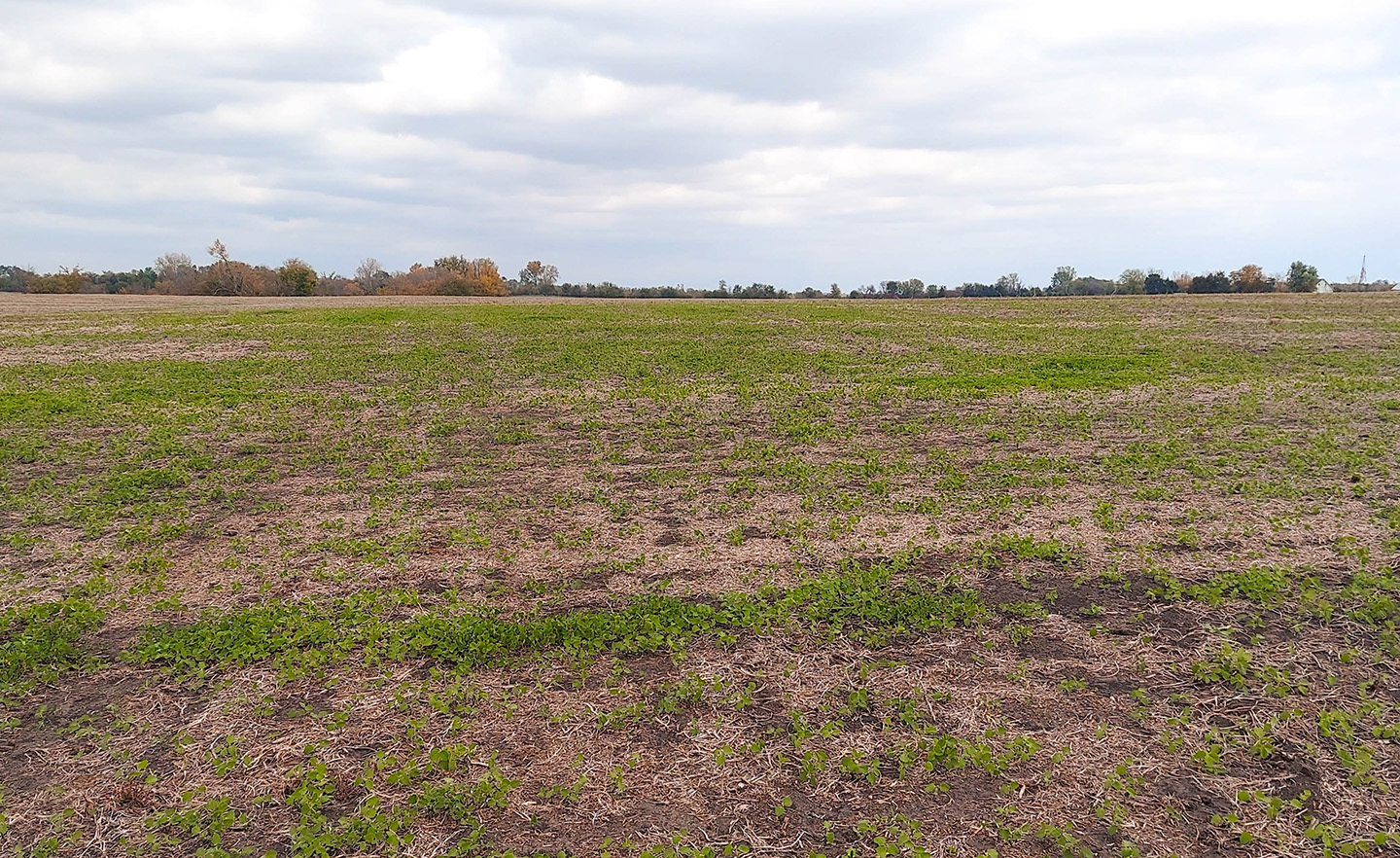
This field turned green with soybeans after harvest last fall due to extensive crop loss at harvest. (Submitted photo).
Minimizing harvest loss
September 22, 2022 | Kriss Nelson
As harvest begins, don’t forget to take the necessary steps to help minimize crop loss at harvest.
Scott Nelson, Iowa Soybean Association (ISA) senior field services program manager reminds producers to look back to issues last fall and to take steps necessary to avoid those factors that can cause a detrimental yield loss this year and lead to problems next growing season.
“Last fall we observed an unusually high amount of harvest loss in soybeans and corn,” he says. “These harvest losses can add up in lost profitability for your farm.”
Harvest loss with corn could haunt you next year.
“Controlling harvest losses in corn is doubly important as these lost kernels will become unsightly yield-robbing weeds next summer,” says Nelson.
Melvin Molitor, ISA farmer-member from Ruthven, is keeping a close eye on his maturing soybeans in northwest Iowa for the right time to harvest.
To help minimize soybean shattering or cracking in the field, Molitor prefers to combine his soybeans at a higher moisture content.
“I prefer starting at 18%, we will get a few loads there, and they will dry down as we go,” he says. “We raise a lot of seed beans, and they do not want cracked beans, so if we can get them at a higher moisture, they won’t crack.”
Molitor realizes he needs to be extra cautious storing higher moisture soybeans.
“We take advantage of those lower humidity days during harvest,” he says. “We will turn the fan on and dry the bottom half of the bin, then turn the fan around and dry the top by sucking the air down through the beans, so we are sure not to over dry the bottom.”
Verify combine adjustments and field conditions
Kapil Arora, Iowa State University Extension field engineer, shared some tips for adjusting your combine to match field conditions.
“These may seem time-consuming, but they can minimize harvest loss as well as profit loss,” he says.
To determine what types of adjustments may be warranted, assess if losses are due to pre-harvest loss or the harvesting process, for example, from the combine head or the threshing cylinder and the separation sieves.
Check for pre-harvest loss
Before combining, walk up and down a few rows to visually check for dropped corn ears or shattered pods, or beans in soybeans. As a rule of thumb, four soybeans or two corn kernels per square foot is equivalent to one bushel per acre loss. This check serves as a baseline to better determine the losses attributed to the combine. This check can be easily performed when scouting to decide the harvest order of the fields.
Check for harvest loss from combine head
Header loss can be responsible for as much as 90% of the total soybean and 60% of the total corn loss. To determine if the loss is from the head, run the combine for 20 to 30 feet and stop before the residue spreads over the harvested rows. Back up the combine to expose the harvested area and assess the number of ears, corn kernels, loose beans, or beans in pods on the ground. A significant increase in the ear, kernel, or bean count on the ground compared to the pre-harvest count indicates that the combined header needs adjusting.
Check for harvest losses from the threshing cylinder and separating sieves
Harvest losses coming from the threshing cylinder and separating sieves can be evaluated by examining the material being discharged from the rear end of the combine. To evaluate, disengage the residue spreader and harvest 50 to 100 feet of row, allowing the residue to be dropped in a windrow behind the combine. Ensure the throughput of the crop through the combine keeps the threshing unit operating near full capacity. Stop the combine and assess the residue windrow for ears, whole or damaged corn kernels, loose or damaged beans, or beans in pods to determine if adjustments need to be made.
General suggestions to minimize losses during harvest
- For soybeans, set the reel speed to approximately 25% higher than the travel speed. If soybeans are lodged, increasing reel speed may help pull the plants in better. Minimize grain damage in the threshing unit by increasing or reducing the feeder house material feed to keep the unit fully loaded. This is achieved by speeding up or slowing down the ground travel speed of the combine to match the field's high yield or low yield areas. In areas of low yields, take care not to increase the ground travel speed excessively such that the threshing unit capacity is exceeded, resulting in increased tailings and grain loss. Harvesting soybeans with green stem syndrome can be challenging because the grain may be dry while the stems are still green. Waiting to harvest until stems are dry may result in significant pre-harvest loss and threshing unit shatter loss. For adequate threshing of the green stem soybeans, pay greater attention to the threshing rotor speed and the rotor-concave clearance to avoid green discoloration of the soybean kernels.
- For corn, match the ground travel speed with the stalk roll speed on the header platform, and ensure that the corn ears are not bouncing off the head.
- For corn and soybeans, match the air speed with the throughput over the sieves to reduce improper separation in high-yield areas or grain loss in low-yield areas with lighter grain kernels. Keep the airflow towards the upper end of the fan speed and reduce fan speed when faced with lighter grain kernels.
Arora advises continuous checking of the combine and field conditions.
“Grain loss and damage can be minimized with proper combine checks during harvest,” he says. “Be vigilant and do not assume crop harvest conditions. Remember to scout fields to prioritize harvest order based on dry-down conditions and assess pre-harvest loss.”
Back